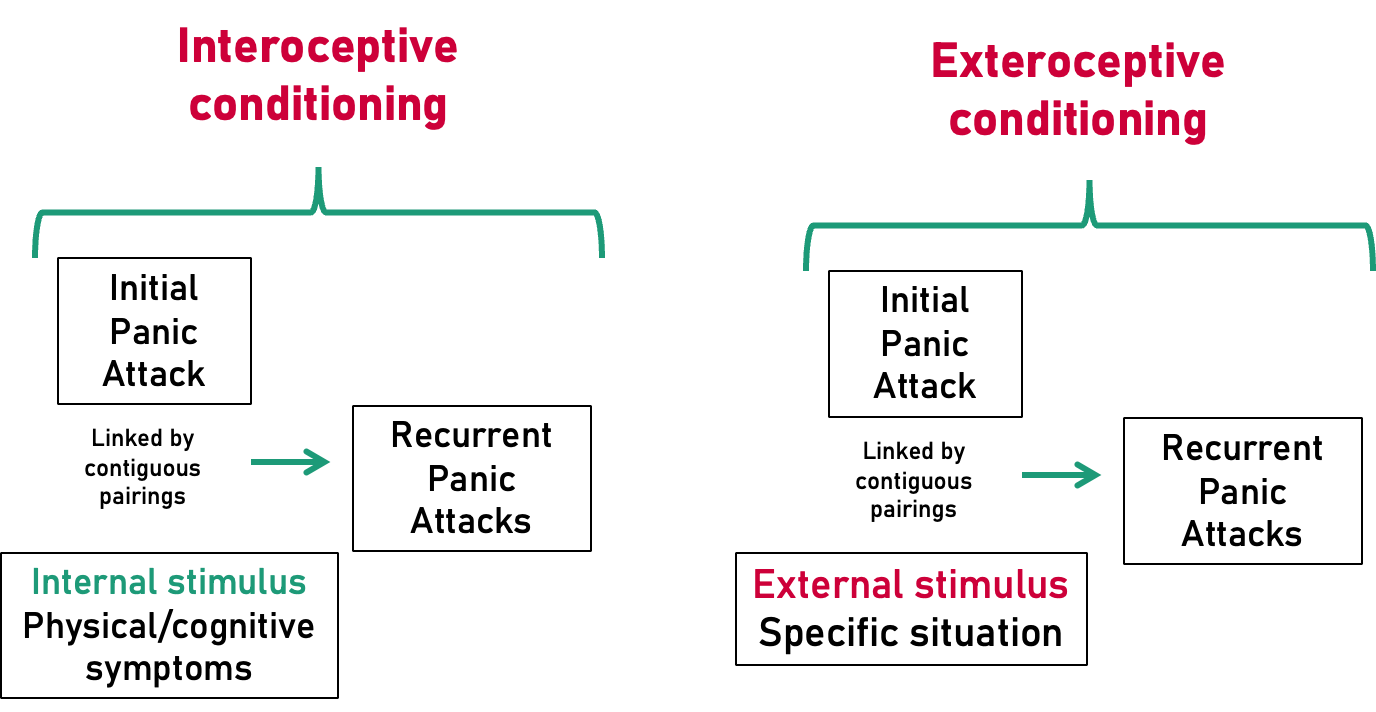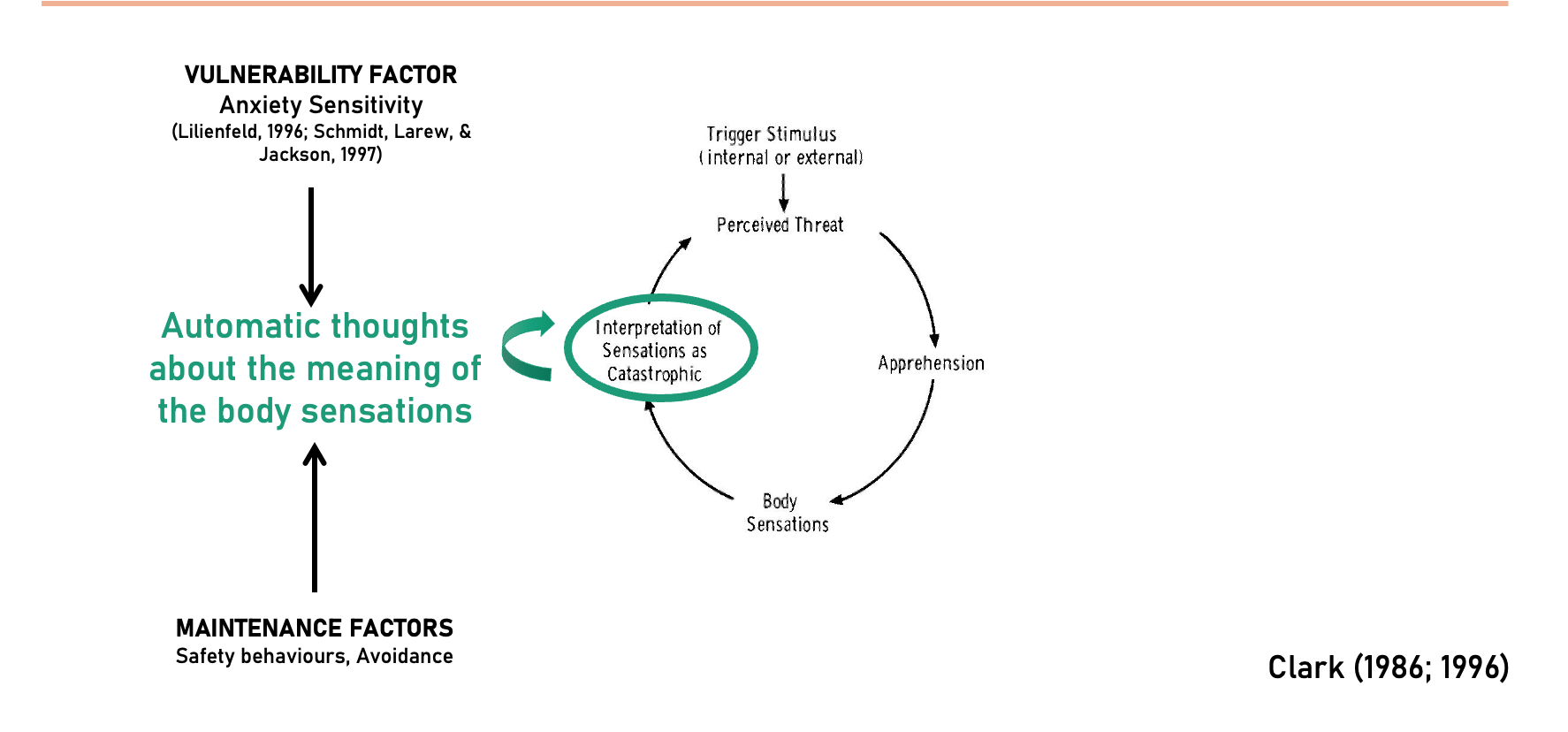Lecture 6- Panic disorder
1/37
There's no tags or description
Looks like no tags are added yet.
Name | Mastery | Learn | Test | Matching | Spaced |
|---|
No study sessions yet.
38 Terms
What is the diagnostic criteria for panic disorder (DSM-5)?
Recurrent unexpected panic attacks- abrupt surge of intense fear or discomfort that reaches a peak within minutes and during which time 4 (or more) of different symptoms can occur
E.g. palpitations, shortness of breath, nausea
At least one of the attacks has been followed by 1 month (or more) of one or both of the following;
Persistent concern or worry about additional panic attacks or their consequences
A significant maladaptive change in behaviour related to the attacks
What is the diagnostic criteria for agoraphobia (DSM-5)?
Marked fear or anxiety about 2 (or more) of the following situations;
Using public transport, being in open spaces, being in enclosed places, standing in line/in a crowd, being outside or home alone
The individual fear or avoids these situations because of thoughts that escape might be difficult or help might not be available in the event of developing panic-like symptoms or other incapacitating or embarrassing symptoms
Almost always provoke fear or anxiety
Actively avoided, require the presence of a companion
Is agoraphobia always diagnosed with panic disorder?
Most often, but some people may have agoraphobia without having panic attacks
May also originate from conditions like epilepsy (where they could also get 'attacks' which might be embarrassing)
Why agoraphobia is now more separated from panic disorder
__% of panic attacks develop after negative life event?
80-90
What is the lifetime prevalence of panic disorder with agoraphobia?
5%, but if not treated, it can continue for a longer period of time
If not treated for over 12 years, less than 50% recover
Can become chronic without treatment
Why is panic disorder more prevalent in women (2x more likely to experience panic attacks)?
Normative gender expectations- more acceptable to report these experiences in women
Men may be less likely to acknowledge or report these attacks
Men and women tend to have different coping mechanisms. What are they?
Expression of fear more acceptable in women
Men cope by drinking, smoking and enduring panic attack (societal expectations influence this)
Women cope by escaping and then eventually increasing avoidance -> more likely to develop agoraphobia
What does the behavioural perspective say about panic disorder?
Classical conditioning
Distinguish two different types of stimulus- internal and external
Related to how the specific person experiences the first episode of the panic attack

Behavioural perspective- what is interoceptive conditioning?
Experience first panic attack-> the thing you notice is your physiological response
Increased heart rate, extreme sweating etc.
This previously unlinked response gets paired with a panic attack
If you feel, in a different situation, your heart rate increasing, you can then develop the response of the panic attack again
Behavioural perspective- what is exteroceptive conditioning?
Experience first panic attack-> the thing you notice is this external stimulus
Location, for example (public transport, busy environment etc.)
Becomes linked with the experience of having the panic attack
Similar situation -> trigger this response again
What does exteroceptive conditioning not account for?
Panic attacks in seemingly pleasant situations
May not be able to identify a feature of the external environment that triggers the panic attack
But interoceptive conditioning could explain this- association between elevated heart rate and the panic response (e.g. at a football game, on a run etc.)
What is a general limitation of the behavioural perspective?
This model doesn't explain where the first panic attack came from, or why some people may develop panic disorder without ever having experienced a full-blown panic attack
Just expresses the link between the situations and intense anxiety response
How could operant conditioning account for the maintenance of the disorder?
Avoidance of anxiety inducing stimulus (negative reinforcement of behaviour)
Also the avoidance of situations that produce a specific internal response
Runner who has a panic attack while running may begin to avoidance other situations that increase their heart rate, make them sweat more etc.
Behavioural perspective- how could generalisation account for the development of agoraphobia?
Generalisation of conditioning to all…
Places, situations where panic attack occurred
Internal stimulus/symptoms experienced ('out of the blue' panic attacks, anticipatory anxiety and agoraphobic avoidance)
The greater the generalisation, the more likely you are to develop agoraphobia
Behavioural perspective- what were the methods in Michael et al.’s (2007) conditioning experiment?
Neutral stimulus paired with an electric shock in individuals with and without panic disorder
Tested if the panic response was generalised to closely related stimuli
Behavioural perspective- what were the findings in Michael et al.’s (2007) conditioning experiment?
Individuals with PD;
Showed greater generalisation of conditioned response
Had slower extinction of conditioned anxiety
Individuals who tend to catastrophise or have a lower threshold to perceive a situation as threatening are much more likely to develop an anxiety disorder
How does behavioural therapy work for those with panic disorder?
Prolonged exposure to feared situations and interoceptive exposure to feared internal situations- has to be an assessment to find out what these feared situations are
Upon exposure, will experience an increase in anxiety that will eventually subside- response is then distinguished from that situation
Progressive exposure to avoid full-on panic attacks (imaging the situation, going with them to the situation, then going by themselves)
Risk has to be controlled this way
How effective is behavioural therapy for panic disorder and agoraphobia?
Useful for 60-75% of people with agoraphobia and effects maintained at 2 and 4 year follow ups
Simple but effective solution- don't really have to do anything on top for it to work
What does the cognitive perspective say about panic disorder?
Doesn't deny the behavioural perspective but puts another layer on top of it
Why CBT still uses behavioural principles
The cognitive perspective emphasises cognition as the mediator in the stimulus -> response pathway (this pairing depends on the cognitive aspect)

What is the cognitive distortion typically present in panic disorder?
Perception of threat around some stimulus (internal or external) which causes apprehension
This cognitive response then leads to these bodily sensations, which are then (mis) interpreted as a sign that something catastrophic will happen
Sense of threat will then increase, and the loop continues
Vicious cycle of panic which continues to escalate- explains the intensity and the peak of the anxiety response being extreme and quick
The catastrophic interpretation never actually happens (e.g. never actually have a heart attack). Why is the fear not extinguished?
Still a really uncomfortable, unpleasant experience- this experience becomes the object of fear, even if the catastrophic outcome never actually happens
Cognitive distortions in panic disorder- what were the methods in Teachman et al.,’s (2007) study?
Multiple methods experiment- questionnaires, IAT, stroop task
E.g. 'You notice your heart beating quickly. The three explanations for this are; you have been physically active, there's something wrong with your heart, or you are excited'
Cognitive distortions in panic disorder- what were the findings in Teachman et al.,’s (2007) study?
Those with panic disorder were more likely to score higher in interpreting their bodily sensations as threatening
Those with panic disorder more likely to say that there was something wrong with their heart, for example (catastrophic thinking)
Why do some people interpret these bodily sensations as threatening and some people do not?
Vulnerability factors and maintenance factors (intervention will usually focus on factors that trigger and maintain these behaviours)
What are vulnerability factors?
Some individuals have this anxiety sensitivity (trait-like belief)
Belief that these bodily sensations will have negative consequences (fast heart beat -> heart attack, for example)
If you have these kinds of trait-like beliefs, then in specific situations, this is more likely to trigger these automatic, catastrophic thoughts
What are maintenance factors?
Safety behaviours, avoidance
Safety behaviours- for example to carry around medication for anxiety
Start to feel some level of anxiety -> take the medication -> will explain why these negative consequences (heart attack, loss of control etc.) never happen
Or, for example, sitting somewhere that makes it easy to leave the room
Anxiety sensitivity in panic disorder- what were the methods in Schmidt et al.’s (1997) study?
1400 adults followed during 5 week military training
Lots of people experience panic attacks during and/or after this training
Use questionnaires to assess anxiety sensitivity before training and then measured how many panic attack-like episodes they experienced and reported
Anxiety sensitivity in panic disorder- what were the findings in Schmidt et al.’s (1997) study?
Association between the level of anxiety sensitivity reported before training, and the experience of panic attacks during the training
Also association between this anxiety sensitivity and depression ratings
Depression symptoms could be a consequence of the inability to cope with the panic disorder
But a too short of a time period for all this to unfold
More sensible to conclude that the vulnerability is not specific to panic disorder
What did Rachman et al. (2008) observe in terms of safety behaviours in panic disorder?
Eliminating safety behaviours is central in CBT…OR can they be used to increase perceived control during therapy?
This was a good tool initially
If you get too anxious you can leave the situation (sense of perceived control)
The individuals didn’t tend to leave, but the knowledge that they could if they wanted to helped
What are nocturnal panic attacks and how many people experience them?
Different from nightmares and other night terrors
50-60% experience a panic attack during sleep
Nocturnal panic attacks can’t be explained by what theory?
Can't be explained by cognitive theory- hard to understand how catastrophic cognitions may develop during sleep
Explained by interoceptive conditioning (but not completely explained as of right now)
What are the aims in CBT for panic disorder?
Recognise that catastrophic thoughts help maintain panic attacks and begin to challenge and restructure cognitions
Psychoeducation for panic disorder involves talking about what?
Adaptive value of anxiety
Function of fight-or-flight response
Panic cycle (but make it more suited to the individual)
For many people, psychoeducation alone is enough as a tool to reduce panic
Cognitive behavioural therapy- what were the methods in Clark et al.’s (1996) study?
Participants with panic disorder who underwent drunk infusion
Cognitive behavioural therapy- what were the conditions in Clark et al.’s (1996) study?
Rationale group
Brief but detailed explanation of what physical symptoms to expect from infusion
Control group
Minimal explanation- giving the individual more opportunity to create their own interpretations, which would likely be catastrophic
Cognitive behavioural therapy- what were the findings in Clark et al.’s (1996) study?
Subjective experience of panic significantly greater in the control group
Subjective report- however it's not the physiological response, but instead their subjective interpretation that's important
What is the typical structure of intervention for panic disorder (5 steps)?
Psycho-education
Self-monitoring of panic attacks
Identification of automatic thoughts and cognitive distortions (ABC model)
Interoceptive exposure
Exposure to feared situations and bodily sensations (without safety behaviours)
How effective is intervention for panic disorder?
70-80% panic free at end of 8-14 weeks, up to 2 years follow up